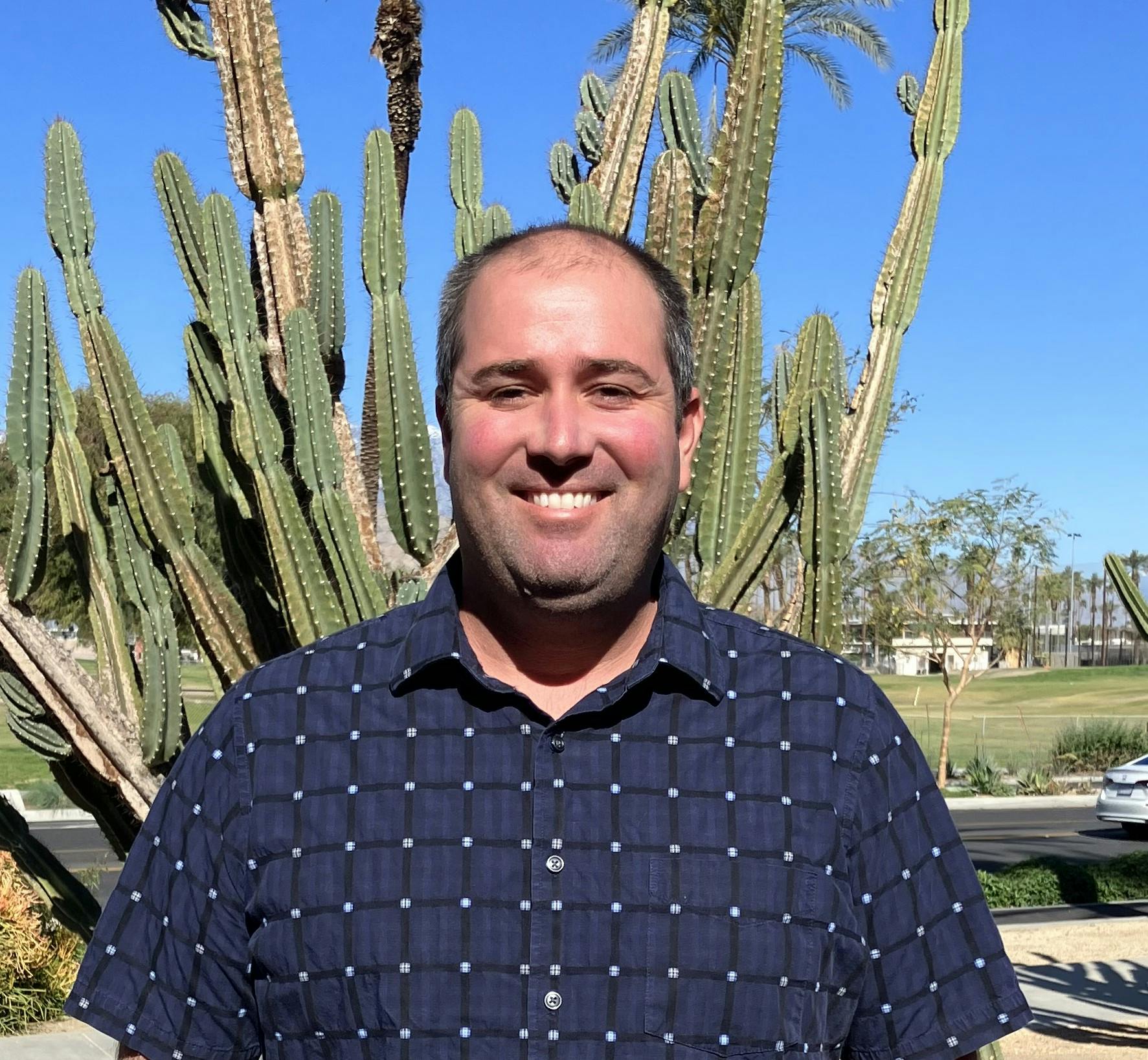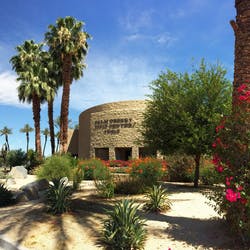Let's Discuss: Active Transportation
 So, What is Active Transportation?
So, What is Active Transportation?
Active transportation refers to human-powered transportation and low-speed electronic assist devices. Active Transportation is critical in developing and implementing sustainable community strategies, reducing greenhouse gas emissions, increasing public health, and making the region a more enjoyable place to live, work, and play.
While Active Transportation traditionally addresses walking and biking, Palm Desert also supports golf carts and public transit in our mobility choices. In addition to expanding mobility options, Active Transportation adds to the accessibility of our roadways and enhances its safety for all users.
Active Transportation goals of The City include
- Adding sidewalks where there is no accessible pedestrian access
- Installation of combination bike/golf cart paths
- Installation of dedicated bike lanes
- Installation of shared bicycle/vehicle-designated roadways
- ADA improvements to sidewalks, curbs, and ramps
- Sidewalk maintenance
Walk & Roll - Filling Gaps in Sidewalks
Who doesn't love biking and walking around our beautiful community? That's not so easy in some places due to gaps in sidewalks, crosswalks, and other infrastructure. Several years ago, the City embarked on a study to identify these gaps and prioritize the improvements needed to help increase connectivity throughout our bike and pedestrian facilities.
Current Status of the Walk and Roll Project:
- Phase 1: Construction Bid Awarded
- Phase 2: Conceptual Plans complete, Design RFP Tentatively scheduled for release beginning of February 2024
- Phase 3: Conceptual Plans Complete
Recent Community Engagement Opportunities
On December 3 and 5, 2024, the City hosted virtual meetings as part of Walk and Roll Phase 2 to explore adding bike lanes to key roads. These sessions invited residents—cyclists and non-cyclists alike—to help shape the future of Palm Desert’s active transportation options.
Feedback was gathered through the Active Transportation page on EngagePalmDesert.com and during the virtual open houses. Please use the following links to view the presentation materials from these meetings:
- Link to recording of the virtual community meeting
- Link to presentation slide deck
- Link to Eldorado Bike Lane Conceptual Designs
Walk and Roll Phase Three Community Meetings
Sidewalks are here and there, but not everywhere. Part of the Walk & Roll active transportation project is to identify these gaps and build continuous infrastructure. This objective is outlined in the City's General Plan, which can be read here.
The streets that have been identified are:
- San Juan from Parkview to Fred Waring
- San Gorgonio from Monterey to San Pablo
- De Anza Way from San Pablo to Portola
- Catalina Way from San Pablo to Portola
- San Pascual from Alessandro to Fred Waring
In April, City Staff held three community events in these identified neighborhoods to explain what effects this project may have. This includes removing landscaping and fencing that is on the public right away and changing to street parking. Below is a map of the streets being considered for building sidewalks. Please note, as seen on the map, several streets have been removed from consideration for this project.

Please click the image to enlarge
On May 23, City staff presented their findings from these community events. Please click here to view the presentation from that City Council meeting.History of Walk and Roll
The City of Palm Desert concluded the Bike and Pedestrian Gap Analysis Study in 2022. The study assessed and identified gaps and recommended prioritized bike and pedestrian infrastructure improvements. This study was used to help City Staff create an implementation plan that categorizes the Walk and Roll project into three main phases, which was approved during the March 23, 2023, City Council Meeting.
The main goal of the overall project is to take ideas outlined in the General Plan and other City-adopted plans to create a more complete and well-connected network for people to walk and bike, as well as focus on new ways to form integrated connections and to reduce mobility barriers for people walking and biking within the pedestrian core of the City.
Phase One – Implementation of "Sharrows"
Phase I of Walk and Roll primarily involves the addition of sharrows (see image below) to various roadways throughout our city.
 |  |
This work is currently under contract, and a Construction Timeline should be outlined shortly.
Phase Two – Bike Lanes
The second phase of the project will heavily involve the installation of Class 2 buffered and unbuffered bike lanes, with the possibility of Class 4 bike lanes (where feasible) throughout the city on the following roads where gaps were identified:
- Portola Avenue
- Gerald Ford Drive
- Cook Street
- Country Club Drive
- El Dorado Drive
- Frank Sinatra Drive
- Oasis Club Drive
- CA-111
Currently, City staff is in the process of releasing a Design-Build Request For Proposal (RFP) to complete the design and construction documents for the implementation of these bike lanes.
Phase Three – Pedestrian Walkways
The Third phase of this project will focus on sidewalk improvements like:
- Installation of new sidewalk
- Side Walk Widening
- ADA Ramps
- Crosswalks
The consultant has created conceptual designs that include alternative options for some street segments. These concepts were discussed at a public community meeting on February 29, 2024.
Chip In and Help Spot Gaps
Your input on this project is essential to its success. Two virtual meetings will be held at key decision points in the project, and this website will be updated regularly.
The City of Palm Desert is developing local connections to the CV Link, Coachella Valley’s regional multi-use pathway, which we call PD Link! As part of the 2016 General Plan, the City of Palm Desert envisions "an interconnected multi-modal transportation system, offering diverse options such as automobiles, public transit, golf carts, bicycling, and walking."
The goal of Palm Desert's PD Link Project is to:
- Identify a network of local corridors that can be developed to provide bicycle and low-speed electric vehicle access to the CV Link and central Palm Desert destinations.
- Select priority corridor(s)/route(s) as the PD Link that will be designed and constructed over the next few years. Other corridors in the network may be considered in the future as funding becomes available.
Golf carts and other electric vehicles are often called Low-Speed Vehicles (LSVs). Similar to bicycles, LSVs can be accommodated on and off roadways in a number of ways.
Current Projects:
Palm Desert's Future Bike & Golf Cart Network
While the CV Link is a regional facility, the City’s General Plan provides a guide to developing local active transportation in Palm Desert. The proposed bicycle and golf cart facility network, adopted within the General Plan, is shown below. The Palm Desert CV Link Connector Project will identify CV Link Connectors and routes in addition to this network.
Potential Bike & LSV Connectors
The project team has developed a preliminary network that connects the destinations listed above. The graphic above shows six potential CV Link Connectors that are being considered for connections between the CV Link and major destinations in the central area of Palm Desert.
Share Your Feedback!
As the City continues to create more opportunities for multi-modal transportation options, public input and support are incredibly important in determining what best meets the community's needs. There are two ways you can help: post an idea or submit a question below!
Project Update: February 12, 2025
Street painting on Haystack Road continues. While most of the lane markings are complete, bike lane indicators will be added on Saturday, February 15, 2025. For clarification on the current lane pattern, please see the graphic below:

Project Update: August 21, 2024
As part of our commitment to improving safety and mobility throughout Palm Desert, the City has designed two key initiatives aimed at enhancing pedestrian safety and reducing traffic speeds along Haystack Road. These projects will be taking place between late August and late October, 2024.
Traffic Signal Improvements
This project focuses on upgrading the signal hardware at the intersection of Highway 74 and Haystack Road. In addition to modernizing the signals, new crosswalks will be added to improve pedestrian access, and pedestrian push buttons will be installed to make crossing the intersection safer and more convenient for everyone.
Haystack Road Traffic Calming
To further improve safety along Haystack Road, new crosswalks will be installed at Alamo Drive, Chia Drive, Moon Lane, and Portola Avenue. In addition, Haystack Road will undergo seal-coating, and lane widths will be narrowed to encourage slower traffic. Buffered, painted bike lanes will be added on both sides of the road to create a safer environment for cyclists while also contributing to the overall traffic-calming effect.
- Click here for renderings of the project
- Click here for a letter that went to homes near Haystack Road on September 19, 2024
What We Know About Haystack Road:
- Haystack Road has one through-travel lane in each direction and a two-way left-turn lane between Hwy 74 and Heliotrope Drive.
- Bike lanes and parking lanes are marked for a portion of the corridor.
- Haystack Road carries 4,700 vehicles per day.
- The speed limit is 45 mph, but about 1/3 of vehicles travel faster than 45 MPH.
- There have been nine vehicle collisions over the last eleven years.
This Study Looks To:
- Studying the safety of the street and traffic.
- Identifying options for improvements.
Recent Staff Reports
| Community Meetings
|
Project Area

Share Your Feedback!
As the City continues to create more opportunities for multi-modal transportation options, public input and support is incredibly important in determining what best meets the community's needs. There are two ways you can help, post an idea or submit a question below!



Thank you for your contribution!
Help us reach out to more people in the community
Share this with family and friends